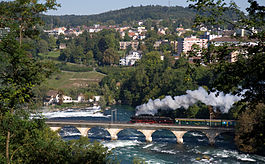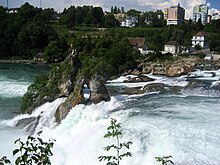Neuhausen am Rheinfall
Neuhausen am Rheinfall | |
|---|---|
 | |
| Country | Switzerland |
| Canton | Schaffhausen |
| District | n.a. |
| Government | |
| • Mayor | Stephan Rawyler FDP/PRD (as of 2008) |
| Area | |
• Total | 7.98 km2 (3.08 sq mi) |
| Elevation | 410 m (1,350 ft) |
| Population (31 December 2018)[2] | |
• Total | 10,510 |
| • Density | 1,300/km2 (3,400/sq mi) |
| Time zone | UTC+01:00 (Central European Time) |
| • Summer (DST) | UTC+02:00 (Central European Summer Time) |
| Postal code(s) | 8212 |
| SFOS number | 2937 |
| ISO 3166 code | CH-SH |
| Surrounded by | Beringen, Flurlingen (ZH), Guntmadingen, Jestetten (DE-BW), Laufen-Uhwiesen (ZH), Schaffhausen |
| Website | www Profile (in German), SFSO statistics |
Neuhausen am Rheinfall (which was called Neuhausen until 1938) is a municipality in the canton of Schaffhausen in Switzerland.
The little town is well known for the Rhine Falls, a tourist attraction and mainland Europe's largest waterfall.
History
Neuhausen am Rheinfall is first mentioned in 900/910 as Niuhusen. In 1253 it was mentioned as Niuwenhusin.[3]
Coat of arms
The German blazon reads: In gelb über grünem Kleeblatt weisses nach rechts gekehrtes Rebmesser mit braunem Griff.
The municipality’s arms might in English heraldic language be described thus: Or in base a cloverleaf couped proper above which a billhook argent hafted proper.
In 1569, Neuhausen bore arms with a gold field and a leaping silver salmon. This symbolized the importance of fishing to the municipality. Shortly thereafter, the arms appeared with different tinctures; the field was now red. With the lessening importance of fishing, the arms, too, presumably ended up being forgotten, for in 1822, arms appeared bearing the current charges, the cloverleaf and the billhook. These two charges illustrate nothing extraordinary and likely stem from the sealmaker’s lack of imagination, for he also chose the same charges for many other municipalities in the Schaffhausen area.
When the coat of arms was revised in 1949, the municipal council and the community association chose the historical arms, as there was a firm basis for them and they were unique for Schaffhausen. Shortly after this decision, though, a referendum was held in which the more modern arms won out.[4]
Geography


Neuhausen am Rheinfall has an area, as of 2006[update], of 8.1 km2 (3.1 sq mi). Of this area, 14.5% is used for agricultural purposes, while 51.3% is forested. Of the rest of the land, 30.9% is settled (buildings or roads) and the remainder (3.2%) is non-productive (rivers or lakes).[5]
The municipality is located in the Schaffhausen district. It used to bey a haufendorf village (an irregular, unplanned and quite closely packed village, built around a central square) on the south foot of the Randen range near the Rhine Falls. Today it is an industrial city. It is located on the south-west border of the city of Schaffhausen. Until 1938 Neuhausen am Rheinfall was known as Neuhausen.[6]
The neighboring municipalities are Laufen-Uhwiesen, Flurlingen, Feuerthalen, Schaffhausen, Beringen, Guntmadingen and the German municipality Jestetten, with which it has a border crossing along Zollstrasse to the southwest of town.
Demographics
Neuhausen am Rheinfall has a population (as of 2008[update]) of 10,080, of which 35.1% are foreign nationals. Of the foreign population, (as of 2008[update]), 16.1% are from Germany, 16.2% are from Italy, 5.3% are from Croatia, 20.3% are from Serbia, 13.1% are from Macedonia, 6.5% are from Turkey, and 22.5% are from another country.[7] Over the last 10 years the population has decreased at a rate of -3.6%. Most of the population (as of 2000[update]) speaks German (81.2%), with Italian being second most common ( 4.3%) and Serbo-Croatian being third ( 4.3%).[5]
The age distribution of the population (as of 2008[update]) is children and teenagers (0–19 years old) make up 17.4% of the population, while adults (20–64 years old) make up 59.8% and seniors (over 64 years old) make up 22.7%.[7]
In the 2007 federal election the most popular party was the Social Democratic Party which received 36.3% of the vote. The next two most popular parties were the Free Democratic Party (33.3%), and the Swiss People's Party (30.5%) .[5]
In Neuhausen am Rheinfall about 64.1% of the population (between age 25-64) have completed either non-mandatory upper secondary education or additional higher education (either university or a Fachhochschule).[5] In Neuhausen am Rheinfall, as of 2007[update], 1.63% of the population attend kindergarten or another pre-school, 6.05% attend a Primary School, 2.62% attend a lower level Secondary School, and 2.49% attend a higher level Secondary School.[7]
As of 2000[update], 27.3% of the population belonged to the Roman Catholic Church and 37.8% belonged to the Swiss Reformed Church.[7]
The historical population is given in the following table:[3]
| year | population |
|---|---|
| 1524 | 12 houses |
| around 1800 | 206 |
| 1850 | 922 |
| 1888 | 2,023 |
| 1900 | 3,905 |
| 1950 | 7,969 |
| 1970 | 12,103 |
| 2000 | 9,959 |
Economy

Neuhausen am Rheinfall has an unemployment rate of 3.25%. As of 2005[update], there were 39 people employed in the primary economic sector and about 9 businesses involved in this sector. 1,664 people are employed in the secondary sector and there are 112 businesses in this sector. 3,082 people are employed in the tertiary sector, with 405 businesses in this sector.[5]
As of 2008[update] the mid year average unemployment rate was 2.8%. There were 509 non-agrarian businesses in the municipality and 37.7% of the (non-agrarian) population was involved in the secondary sector of the economy while 62.3% were involved in the third. At the same time, 73.5% of the working population was employed full-time, and 26.5% was employed part-time. There were 5,313 residents of the municipality who were employed in some capacity, of which females made up 41.9% of the workforce. As of 2000[update] there were 1,428 residents who worked in the municipality, while 3,077 residents worked outside Neuhausen am Rheinfall and 2405 people commuted into the municipality for work.[7]
As of 2008[update], there are 26 restaurants, and 3 hotels with 112 beds. The hospitality industry in Neuhausen am Rheinfall employs 185 people.[7]
Neuhausen is home to a number of manufacturing firms. Some of the best-known are: The playing card company of AGM AGMüller, the cotton wool factory IVF Hartmann AG, the packaging company Schweizerische Industrie Gesellschaft (SIG) and the former Alusuisse factory, which is now part of the Alcan-Group.
Transportation
There are three railway stations within the municipality of Neuhausen am Rheinfall. Neuhausen station is served by S-Bahn Zürich routes S9, S24 and S33. Neuhausen Rheinfall station is also served by route S9. Neuhausen Bad station is served by trains on the Deutsche Bahn's Upper Rhine Railway.
Cultural Heritage
Wörth Castle
The Wörth Castle owes its name to the location on a small island, washed by the water of the Rheinfall, which used to be known as Werd, meaning literally a river island. Wörth was first mentioned in the 13th century AD, serving up to the middle of the 19th century as a major transhipment point on the east-west trade route, that led from Lake Constance and Basel, and was interrupted by the Rheinfall waterfalls. When the railway was built, the water traffic route lost its importance, and the Canton of Schaffhausen rebuilt the building as a restaurant in 1835/36.[8]
Heritage sites of national significance
The house Villa Charlottenfels at Charlottenweg 2 is listed as a Swiss heritage site of national significance.[9] Villa Charlottenfels was built in 1850-54 as a Renaissance Revival castle-like building. Originally built to house a factory, it features wide terraces with covered arcades and pavilions. The southern pavilion contains a mural by Hans Bendel which has a Swiss history theme.[10]
Notable people
- Dölf Wild (1954), historian and archäologist
References
- ^ a b "Arealstatistik Standard - Gemeinden nach 4 Hauptbereichen". Federal Statistical Office. Retrieved 13 January 2019.
- ^ "Ständige Wohnbevölkerung nach Staatsangehörigkeitskategorie Geschlecht und Gemeinde; Provisorische Jahresergebnisse; 2018". Federal Statistical Office. 9 April 2019. Retrieved 11 April 2019.
- ^ a b Neuhausen am Rheinfall in German, French and Italian in the online Historical Dictionary of Switzerland.
- ^ Bruckner-Herbstreit, Berty: Die Hoheitszeichen des Standes Schaffhausen und seiner Gemeinden, Reinach-Basel 1951, S. 231-234.
- ^ a b c d e Swiss Federal Statistical Office accessed 16-December-2009
- ^ Amtliches Gemeindeverzeichnis der Schweiz published by the Swiss Federal Statistical Office Template:De icon accessed 23 September 2009
- ^ a b c d e f Statistical Office of the Canton of Schaffhausen Template:De icon accessed 2 December 2009
- ^ "Schlössli Wörth" (in German). rheinfall.ch, Wörth Castle. Retrieved 2014-12-29.
- ^ Swiss inventory of cultural property of national and regional significance 21.11.2008 version, Template:De icon accessed 16-Dec-2009
- ^ Flüeler (1982). Kulturführer Schweiz (in German). Zurich, CH: Ex Libris Verlag AG. p. 262.
External links
- Neuhausen am Rheinfall in German, French and Italian in the online Historical Dictionary of Switzerland.


